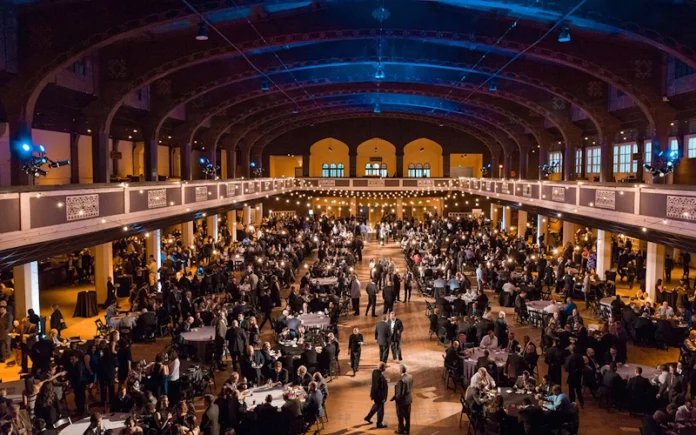Trade show exhibits might look like flashy booths and product displays, but they’re more than that. These setups are reflections of the time and culture in which they’re built. Just like music, art, or film, trade show exhibits show us what society values, what it fears, and what it’s dreaming about.
From the grand pavilions of World’s Fairs to today’s minimalist tech showcases, exhibits have evolved in design, message, and purpose. They tell stories—not just of brands, but of eras. And when we zoom out, these stories reveal something bigger: how our world has changed, and what we believe matters most.
The Origins of Trade Shows: Where Culture Met Innovation
The 1800s: The Spectacle of Industry and Empire
The modern concept of trade shows started with World Expositions, like London’s Great Exhibition of 1851. These massive events weren’t just about showcasing goods. They were cultural showcases, proudly displaying the industrial power and colonial reach of empires.
Booths were grand, elaborate, and nationalistic. They celebrated invention, machinery, and “civilized progress.” The layout itself mirrored a world order, placing European countries in prime locations while colonies occupied the margins.
This early era of trade show exhibits reflected a society obsessed with power, conquest, and mechanical innovation.
1900s: A Shift to Utopia and Futurism
As the 20th century unfolded, exhibits began to shift. The 1939 New York World’s Fair imagined “The World of Tomorrow.” Exhibits used light, motion, and architecture to create immersive experiences. They weren’t just selling products—they were selling visions of a better future.
Trade show exhibits have now become storytelling spaces, packed with optimism and tech dreams. This reflected the cultural push toward modernization, post-war hope, and the growing fascination with science fiction.
Mid-Century Modernism and Corporate Power
1950s–70s: Rise of the Corporate Pavilion
In the mid-1900s, big brands began dominating the exhibit scene. General Motors, IBM, and Bell Labs created exhibits that looked more like film sets than trade booths. Sleek, curated environments became standard.
Why? Because society was now driven by consumerism and corporate trust. Exhibits mirrored that faith. Clean lines, futuristic fonts, and automation displays reflected a culture where progress was brand-driven.
Trade show exhibits became a place where people went to witness “the future” as imagined by corporations. And they bought into it—both literally and figuratively.
1960s–70s: The Counterculture’s Shadow
Even in this corporate era, a quiet cultural rebellion was brewing. Some exhibits at art and tech shows embraced psychedelia, environmentalism, and anti-war messaging. They were less polished but more raw and honest.
This contrast showed a society split between the polished ideal of mass consumption and the emerging voices challenging it.
H2: The Digital Age: Interactive, Minimal, and Hyperconnected
1980s–2000s: From Hardware to Software
As the world went digital, so did trade show exhibits. Gone were the bulky machines, replaced by screens, interfaces, and the buzz of new software.
The look and feel of exhibits shifted too: modular walls, demo screens, neon lights, and interactivity. Brands like Microsoft, Apple, and Sony led the way, creating booths that felt like sci-fi sets.
This era reflected society’s growing obsession with connectivity and speed. The world was now hooked on fast updates, cutting-edge tech, and ever-smaller devices. And the booths followed suit—leaner, faster, and more digital.
Startups and Simplicity
By the early 2000s, the startup boom brought a new aesthetic. Forget grandeur—now it was about authenticity and minimalism.
A folding table, some branded swag, and a good story were enough. This was the era of disruption, and the booths reflected it. Lean, clean, and focused on the pitch.
Exhibits now mirrored a society that valued ideas over infrastructure, innovation over legacy.
Trade Shows as Time Capsules: What Will the Future Bring?
What we see at trade shows today may feel ordinary. But in 50 years, they’ll be cultural relics—just like the steam-powered marvels of the 1800s.
Will future exhibits focus on AI ethics, space colonization, or mental wellness? Likely all of the above. Because trade show exhibits don’t just show off products—they capture what a generation is thinking, fearing, and hoping for.
Conclusion
So next time you walk through a trade show, look closer. Every booth, every display, every lighting choice—it all tells a story. Not just of a company, but of an era.
From colonial showcases to green-powered walls, trade show exhibits evolve as our values evolve. They’re not just business spaces—they’re cultural stages.
By seeing them through this lens, we gain a new appreciation for the role they play. They don’t just reflect trends—they help define them.
FAQs
1. What is the purpose of trade show exhibits beyond marketing?
Trade show exhibits also reflect cultural values, design trends, and societal priorities like sustainability or diversity. They’re visual time capsules of their era.
2. How have trade show exhibits changed over time?
Exhibits evolved from elaborate empire showcases to sleek tech-driven spaces. They’ve shifted from showing off machinery to storytelling and immersive design.
3. Why are some trade show booths so minimal today?
Minimalism reflects modern values like authenticity and innovation. Startups often use clean, simple booths to emphasize ideas over appearance.
4. How do trade show exhibits support inclusivity and sustainability?
Brands now design accessible, eco-friendly booths using recyclable materials and inclusive messages, showing a shift in societal awareness and ethics.

